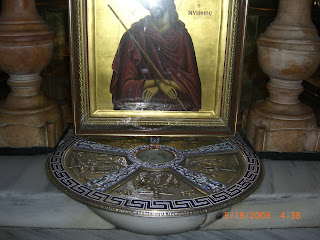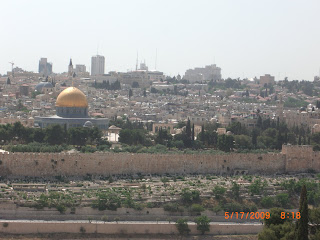 Near the base of the Mount of Olives stands the Church of the Nations. This church embraces a stand of olive trees which almost certainly date back to the time of Jesus, and beneath the altar of the church lies a rock claiming to be the place where Jesus fell to his face and called out to God in anguish to "let this cup pass from me."
Near the base of the Mount of Olives stands the Church of the Nations. This church embraces a stand of olive trees which almost certainly date back to the time of Jesus, and beneath the altar of the church lies a rock claiming to be the place where Jesus fell to his face and called out to God in anguish to "let this cup pass from me."The Garden of Gethsemane plays a crucial role in the unfolding of the gospel of Jesus. His public ministry is at its end. Friends have conspired to betray him. Even as the story opens, a crowd including a few members of the Temple Guard is on its way to arrest Jesus and initiate that grueling last day of his life that we have come to call the Passion.
Visitors to the garden today find a carefully manicured landscape and a starkly beautiful chapel commemorating the events of this place. Central to the memory, of course, a
 re the olive trees.
re the olive trees.Olive trees, properly cared for can live virtually forever. As I toured the gift shops of the Holy Land, I came to wonder how there could be any olive trees left. Olive wood is sold as a souvenier of the place in every shop, restaurant, hotel lobby and (often) out of the trunks of cars along the side of the road. What I learned is that trees are not felled to harvest the lumber. Instead, the carvings are produced from branches that have been pruned away to foster newer, more vital growth. The dozen or so trees in the garden seem to absorbed the spirit of the place. Their trunks are twisted and gnarled, as if they, too, kneel in anguish.
This anguish is recalled by the architecture, as well. And by the art. A stone carving tucked inauspiciously in one corner of the garden shows Jesus draped across a stone, praying.

The central mosaic over the altar in the nave shows us a similar scene, this time with angels in attendance (as suggested by the gospel of Luke. To the right of the altar, another mosaic shows the ill-fated kiss of betrayal (as suggested by Matthew and Mark.)
To the left of the altar, though, we find a different scene taken from the gospel of John. In this scene, the arresting officers have arrived, and Jesus has offered himself for arrest. The artist has given Jesus a transcendent glow in this panel, and the soldiers are shown stricken with awe, driven to their knees.
In fact, the four gospel writers each present their own particular version of what happened in Gethsemane that night. Luke's version is perhaps the most familiar and most detailed:
22:39Jesus went out as usual to the Mount of Olives, and his disciples followed him. 40On reaching the place, he said to them, "Pray tha
 t you will not fall into temptation." 41He withdrew about a stone's throw beyond them, knelt down and prayed, 42"Father, if you are willing, take this cup from me; yet not my will, but yours be done." 43An angel from heaven appeared to him and strengthened him. 44And being in anguish, he prayed more earnestly, and his sweat was like drops of blood falling to the ground.c]">[c]
t you will not fall into temptation." 41He withdrew about a stone's throw beyond them, knelt down and prayed, 42"Father, if you are willing, take this cup from me; yet not my will, but yours be done." 43An angel from heaven appeared to him and strengthened him. 44And being in anguish, he prayed more earnestly, and his sweat was like drops of blood falling to the ground.c]">[c] 45When he rose from prayer and went back to the disciples, he found them asleep, exhausted from sorrow. 46"Why are you sleeping?" he asked them. "Get up and pray so that you will not fall into temptation."
47While he was still speaking a crowd came up, and the man who was called Judas, one of the Twelve, was leading them. He approached Jesus to kiss him, 48but Jesus asked him, "Judas, are you betraying the Son of Man with a kiss?"
49When Jesus' followers saw what was going to happen, they said, "Lord, should we strike with our swords?" 50And one of them struck the servant of the high priest, cutting off his right ear.
51But Jesus answered, "No more of this!" And he touched the man's ear and healed him.
52Then Jesus said to the chief priests, the officers of the temple guard, and the elders, who had come for him, "Am I leading a rebellion, that you have come with swords and clubs? 53Every day I was with you in the temple courts, and you did not lay a hand on me. But this is your hour—when darkness reigns."
Here we have the anguished prayer of surrender. Jesus lays aside his own will in order to accept the will of the Father. He arises from this prayer empowered to "resist temptation," just as he has advised his disciples to do the same.Luke's telling of the story is a little more compassionate towards the disciples than Matthew or Mark. Luke suggests that their sleepiness is born of grief, rather than the complete cluelessness that seems to be implied in Matthew and Mark. Luke alone reports that Jesus heals the ear lopped off in the ensuing fray. No harm, no foul. He even goes so far as to suggest that Jesus stops Judas shy of the diabolical kiss.
A careful comparison of the words prayed by Jesus in each of these three gospels shows some subtle differences. This is to expected of course. The disciples were left behind at some distance and were not at their sharpest. It's absolutely normal that they would remember the event with some confusion.
Matthew remembers Jesus saying "If it is possible... let this cup pass from me." It is a call of anguish which nevertheless recognizes that for God's plan to unfold, what comes next may be utterly unavaoidable. Luke doesn't speak of what's possible, but of what's desirable. In his mind, this story is all about seeking God's will at any cost.
Mark's version of the prayer is the most heart-wrenching. He begins by noting "All things are possible for you..." In other words, "I know you could find another way. Leave me out of this!"
What each holds in common, of course, is a very human Jesus wishing there were another way, but ultimately yielding to the greater purposes of God.
When we turn to John's account (John 18:1-11), though, we find a surprise. John reports no prayer whatsoever. Completely missing are the agonized moments of struggle with h
 is conscience and his humanness. The closest thing John gives us is actually back in chapter 12:23-33, while Jesus and the disciples are still in the upper room. There, he confesses to his disciples that he is deeply troubled by what is coming next. Even her, though, Jesus pointedly refuses to pray for God to spare him the coming hour. John's Jesus marches to Gethsemane not to wrestle with his personal demons, but to confront his destiny head on.
is conscience and his humanness. The closest thing John gives us is actually back in chapter 12:23-33, while Jesus and the disciples are still in the upper room. There, he confesses to his disciples that he is deeply troubled by what is coming next. Even her, though, Jesus pointedly refuses to pray for God to spare him the coming hour. John's Jesus marches to Gethsemane not to wrestle with his personal demons, but to confront his destiny head on.Both pictures are preserved at the Church of Nations, just as both are preserved in our own holy scriptures. We have the human Jesus, emotionally spent, sweating drops of blood, crushed under the weight of the demands placed on him by our salvation. And we have the divine, glow-in-the-dark Jesus who never for a moment contemplates the possibility of turning aside from the cross. Which is it?
Will the real Jesus of Nazareth please stand up?
Like the Mosaics and our fourfold gospels, orthodox Christianity has consistently told us that we need both pictures. We proclaim Jesus both fully human and fully divine. Good theology leaves us somewhere in the mystery between, grasping one Jesus with each hand. Our human mind seems incapable of holding the two pictures together, but the gospel writers insist we cannot have one without the other.










